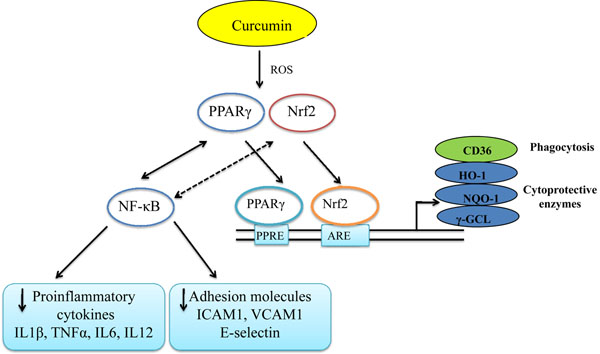Figure 2.
Schematic diagram illustrating the main biological targets of curcumin that can be exploited in suppressing immunopathological events associated with cerebral malaria. Upon exposure of cells to curcumin, a transient induction of reactive oxygen species (ROS) may occur. This potentially leads to activation of a signalling cascade involving the peroxisome proliferator activated receptor gamma (PPARγ) and induction of the redox-sensitive factor Nrf2. Activated-Nrf2 and PPARγ translocate in the nucleus, where they bind to their target genes via their respective binding sites,the anti-oxidant response element (ARE) for Nrf2 and the peroxisome proliferator response element (PPRE) for PPARγ. In monocytes/macrophages activation of Nrf2 or PPARγ will lead to upregulation of the surface expression of CD36, increasing their phagocytic activity [55]. In other cell types such as endothelial cells, activation of Nrf2 and PPARγ may lead to upregulation of cytoprotective enzymes [haem oxygenase 1 (HO-1), NADPH quinine oxidoreductase-1 (NQ-1), gamma-glutamate cysteine ligase (γ-GCL)], counteracting free radical-induced damage and exerting a neuroprotective effect [87]. On the other hand, PPARγ (solid arrows) and perhaps Nrf2 (dashed arrows) could exert their anti-inflammatory activities by inhibiting NF-κB activation, thereby downregulating proinflammatory cytokine responses and adhesion molecule expression which are all implicated in the pathology of CM.

